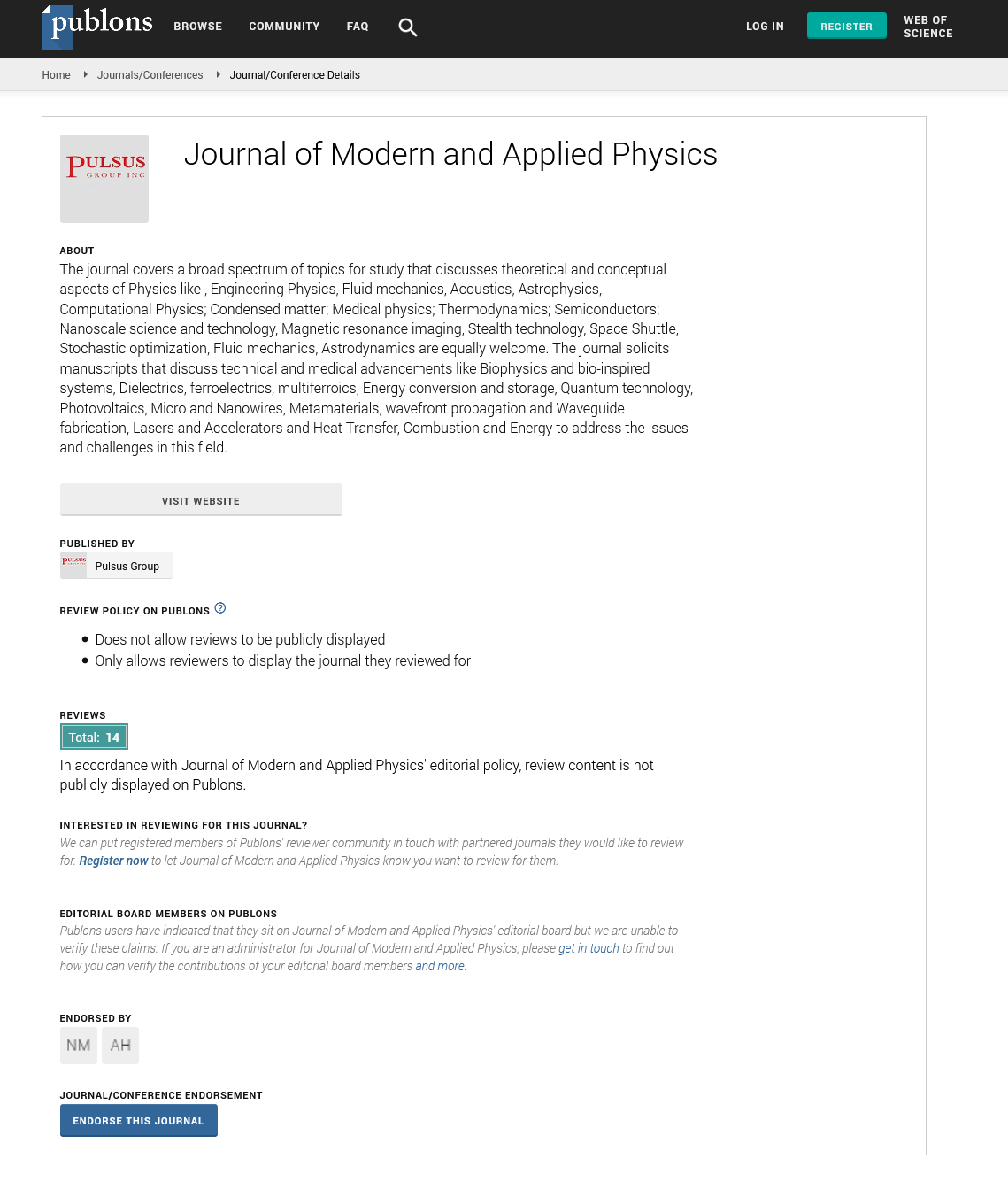Information and effect An introduction to the concept of immanence as a physical quantity
Received: 10-Apr-2023, Manuscript No. puljmap-23-6353; Editor assigned: 12-Apr-2023, Pre QC No. puljmap-23-6353(PQ); Accepted Date: Apr 28, 2023; Reviewed: 14-Apr-2023 QC No. puljmap-23-6353(Q); Revised: 21-Apr-2023, Manuscript No. puljmap-23-6353(R); Published: 18-May-2023, DOI: 10.37532.2022.6.2.1-6
Citation: Joge F.M. Information & effect an introduction to the concept of immanence as a physical quantity. J Mod Appl Phys. 2023; 6(2):1-6.
This open-access article is distributed under the terms of the Creative Commons Attribution Non-Commercial License (CC BY-NC) (http://creativecommons.org/licenses/by-nc/4.0/), which permits reuse, distribution and reproduction of the article, provided that the original work is properly cited and the reuse is restricted to noncommercial purposes. For commercial reuse, contact reprints@pulsus.com
Abstract
The introduction and application of the concept of immanence as a physical quantity allows a broader understanding of effect. Mathematical formulations present the complementary co-factors of information and immanence as the cause and result respectively of the thermodynamic effect. Thus, the concept of immanence helps to clear up the relation between the concepts of information and reality and leads to the derivative of the principle of immanence development which might be applied to problems in astrophysics, e.g. in the discussion on the information paradox (i.e. the question of information loss regarding black holes).
Key Words
Astrophysics effect, Thermodynamic, Information, Immanence; reality
Introduction
In today's information age, the term "information" has become more and more important. We are living in a time of renewed paradigm shift, away from the traditional concepts of energy and matter to the prevailing concept of information in today's information age. Although the concepts of energy and matter are still present and important in our world, they are increasingly being replaced by the concept of information. This applies not only to biology with its deeper biochemistry and molecular biology but also to physics. This is where the term "information" plays an increasingly important role alongside energy and matter as the third fundamental quantity. The American physicist John Archibald Wheeler considers an information-theoretical reformulation of quantum theory, in general, to be promising. He once said: "Tomorrow we will have learned how to understand all physics in the language of information and how to express it in this language". The experimental physicist Anton Zeilinger, Vienna, even equates information with reality. Even if reality is not a concept of physics and the concept of effect has no particularly descriptive meaning in physics, one can understand physical reality as a single effect or as the sum of all effects. Then the question of a quantitative connection between information and effect arises. This connection could help to understand the effect more comprehensively with the help of the concept of information and to relativize Shannon’s information theory by taking it onto a semanticpragmatic level.
Background
Like matter and energy, we encounter information in various forms such as literature, encyclopedias, telephone books, news via telecommunication satellites or even communication via jungle drum, language (communication), sheet music, material-related structural information as properties, genetic information (DNA, genome), proteomic information (proteomics, proteomes), hormones and the immune systems of organisms, pheromone language of insects, computer programs, circuit diagrams of a chip and technical drawings. It appears as potential, current, bound, and free information as well as structural, functional, and dynamic information and possesses, among other things, statistical, syntactic, logical, semantic, pragmatic, sigmatic, and teleological and transcendent1 aspects [1].
Looking at the different manifestations of information, two directions of development can be seen: one direction from complex to simple, characterized by the terms decomposition, degradation, analysis, and reduction, and an opposite direction from simple to complex, characterized by the terms synthesis, construction, optimization, and evolution. These developments represent the production and transformation of information and always take place in the environment of an effective mechanism. The direction of higher development is generally called evolution. The two directions of development do not always have to be directed one-sidedly downward or upward.
The proposed definition of information
A general proposal for a definition of information in compact terms that could be valid for all scientific disciplines in the age of language confusion in relation to the concept of information would be:
Information is the composition of an ensemble of symbols of a certain sequence. This definition includes all essential aspects of the concept of information such as statistics, syntax, semantics, and pragmatics. The formulation "certain sequence" refers to semantics and, inextricably linked with that, to pragmatics (semanticspragmatics). Likewise, the phrase "composition of an ensemble" refers to statistics, where the terms "probability of a composition" and "canonical ensemble" are used.
Mathematical description of effect with the help of the concept of information
The effect is understood in information theory as a pragmatic aspect of information [2, 3]. How one can imagine the unfolding of effect and what role information plays in this is shown in research by elucidating mechanisms of action and the control of life development by genes. So far, however, the mathematical treatment of the relationship between the terms information and effect has not been very pronounced.
L. De Broglie for the first time developed a formula (1) in the context of the thermodynamics of the isolated particle, which can be found in the pocketbook "Waves and Particles" [4]. It describes the equivalence of thermodynamic entropy S and effects A. The thermodynamic entropy S in turn has a proportional relationship to Shannon's information entropy H {see equation (2)}. This relationship is generally accepted in physics today, if one considers entropy as potential information, i.e. as a measure of the number of possible microstates in the macro state.
Entropy is associated with the number of yes-no questions (bits) needed to determine a particular state. The more information one has, the fewer questions have to be asked and the lower the entropy (entropy as missing information) [5].
Thus equation (1) becomes equation (3) and, after division by the time t, this leads to the equivalence of information flow H/t and energy {equation (4)}, which was first postulated by Hartmut Ising in 1996 and means an extension of the law of energy conservation [6]. The experimental verification of this hypothesis is still pending but has already been mentally prepared [6]. With reference to Greek philosophy (Philo of Alexandria, 1st century A.D.) Ising refers to the flow of information as "dynamic information".
Lienhard Pagel has also described the equivalence of information flow and energy, derived a sentence on the preservation of "dynamic information" and examined its usefulness [7].
The De Broglie formula (1) and the Pagel formula correspond. While De Broglie uses thermodynamic entropy, Pagel employs Shannon's information entropy.
Also in quantum theory, the concept of information is linked with the concept of probability, namely with Born's probability interpretation of the wave function ѱ, which can be understood as potential information. This expression of physical entropy presents itself differently from Shannon's information entropy; for the latter is based on the distinguishability of the signs or the underlying binary alternatives respectively. On the other hand, the indistinguishability of the microstates must be taken into account in the quantum theoretical representation. But for the treatment of the concept of immanence presented here, the "classical" information concept of Shannon is taken as the basis in accordance with the statement of Niels Bohr, according to which the representation of all experience must take place in classical concepts.
Application of equations (4) and (8)
With the help of equation (4), the information content HM of our universe can be calculated as follows:
For the theoretical calculation, the universe is regarded as a single black hole, just as one imagines the final stage of the universe according to a common theory [8]. With the black hole entropy (Bekenstein-Hawking entropy):

And, hawking temperature

one then gets the equation

If one then sets 
and for the area of the event horizon of the black hole, which measures the information potentially contained in it, then for the mass M of the universe, one gets
for the area of the event horizon of the black hole, which measures the information potentially contained in it, then for the mass M of the universe, one gets
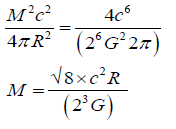
Using the hubble relationship R = c / H0 leads to

By inserting the hubble constant H0 = 2.285×10-18 s-1 one gets for the mass of the universe H0 = 70.5 km s-1 Mpc-1 according to WMAP5 M = 6.25×1052 kg
According to E=Mc2 this mass corresponds to
EM = 5.6×1069 J ≈ 1070 J
a numerical value that Stephen Hawking also calculated for the entire current mass-energy equivalent of the universe [9].
This theoretically calculated value, which corresponds to 1080 proton masses and which makes up the major part of the energy of the cosmos primarily in matter form, can be compared with the value calculated from the volume and density of the universe [10]. If one uses a radius of 13.8 billion light-years for size 1, then this value results in

which is a rather good match, considering how difficult it is to obtain astrophysical data by observation and calculation.
Application of equation (4)
With equation (4)

the information content HM of our universe can now be calculated from the 1070 J mass energy equivalent for the universe as follows if the age of the universe (13.8 billion years = 4.376×1017s) is used for the time t:
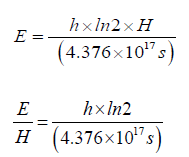
E = 1.05× 10−51 J for the energy per bit
This leads to
1070 J / 1.05×10-51 J = 10121 bits
for the information content of the universe, which corresponds well to the values given in the literature [11-13].
Application of equation (8)
Based on the current cosmological data (standard model), a mass energy of 0.9×1099 J can be calculated for the proximity of the Big Bang (t=10-44s, T=1032K, size=10-32, density=1096g /cm3 ).
This is where size 1 (today) corresponds to a radius of 1.34×1028 cm (R= c /H0)
and size 10-32 to a radius of 1.34×10-4cm, corresponding to a volume of (4/3)πR3 = 1.02×10-11cm3 . This volume corresponds with the density 1096g /cm3 to a mass of 1.02×1085g or 0.9·1099 J ≈ 1099 J.
According to equation (8) the bound energy is

and the heat equivalent of one bit

Dividing the energies by the heat equivalent of a bit results in 1099 J / k×ln2×1032 K = 1090 bits for the time of the Big Bang and 1070 J / k×ln2×2.7 K = 3.87×1092 bits for today.
If one now compares the mass energy of the universe calculated from the current cosmological data at the beginning and today, then one determines a 1029-fold mass-energy decrease according to the standard model. This is contrasted by a 1032-fold temperature decrease and a 1032-fold entropy/information increase as well as a 1032-fold increase in size. In addition, the time increases 1064-fold.
So if one only considers the relative conditions, the following picture results if the scale and dimensions are chosen accordingly:
Information increase ≈ Size increase ≈ Temperature decrease ≈ Time increase ≈ Size Increase
Mass energy and information balance of the universe
If the values found are entered in Tables 1 and 2, the following figure results (see [14]):
TABLE .1 Mass energy and information balance of the universe
| Symbol | % | Information 10122 (bit) | Energy 1071 (J) | Mass !053 (kg) | (J/bit) | |
|---|---|---|---|---|---|---|
| Dark energy | HDE | 70 | 0.943 | 0.994 | ||
| Dark matter | HDM | 25 | 0.337 | 0.355 | 3.9 | |
| Visible baryonic matter | HM | 4 - 5 | 0.054 | 0.056 | 0.625 | 10-51 |
| Neutrinos | Hneu | 0.3 | 0.004 | 0.0043 | ||
| Hu | !00 | 1.338 | 1.4093 | |||
| MKG | 4.5 |
TABLE .2 Mass energy and information balance of the universe
| Information (bit) | Energy (J) | Mass (kg) | (J/bit)T(K) | Inf.T | (bit.KL) | |
|---|---|---|---|---|---|---|
| Universe at time of the Big Bang | 1090 | 1099 | 1.15*1082 | 109 | 1032 | 10122 |
| Visible baryonic 10-6s matter | 1088 | 1077 | 10-11 | 1012.5 | 10100 | |
| Universe Today | 10121 | 0.56*1070 | 0.625*1053 | 10 |
2.7 | 10122 |
Introduction to the concept of immanence as a physical quantity - temperature as an immanence formation velocity (immanence production)
In nature and technology, processes can be observed in which the product of temperature and time (T · t) has a meaning [13]. For example, the product T · t seems to act as a co-factor in a kind of "internal clock" when seasonal changes occur, such as when the trees "break out" in spring or when crocuses' calyxes open and close. This is where, in the field of climatology, the term temperature sum is used. It is needed, for example, in agriculture to determine how plants flourish with this calculated size. This means that the plants only thrive well if, for example, a certain value of the temperature sum is reached in one month ("vitality rate").
In steam and hot air sterilization and pasteurization to kill microorganisms, on the other hand, the term "lethality rate" is used. The elevated body temperature (fever curve) and its course in viral infections, sauna use, Kneipp's water applications, hypnotherapy and hypothermia therapy, breeding of birds (the birth of life), melting of ice at the polar caps of the earth and the associated rise in sea levels, the evaporation of ice from car windows after a cold winter night, the increased depletion of the earth's ozone layer after very cold winter periods and the process of cooking potatoes can be cited as further examples where it is important to maintain the temperature over a certain period of time and thus achieve a certain effect. In general, temperature and time are important for all chemical reactions, including biochemical reactions.
If we now introduce the physical quantity I = Immanence (Latin for indwelling, adherence) as the temporal root function of temperature, this quantity can be defined as I = T · t or dI = T · dt {equation (5)}. Thus, using the bound energy Qg = TS, the extended mathematical equations (6) and (7) are obtained for the relationship between the terms information and thermodynamic effect Qg · t.
Equation (8) represents an extended relationship (compared to equation (4)) for the connection between information flow and bound energy.
The description for the more general case includes the free energy F {see equation (10)}. Finally, De Donder's irreversibility performance P can also be used to formulate an irreversibility effect (see equation (12)).
These formulations (6), (7), (10), and (12) show the complementary co-factors information and immanence as the cause of the effect. Conversely, information results from effect.
Equation (6) is converted into De Broglie's formula (1) or Pagel's formula for the special case that the immanence is constantly h / k, thus containing both as a special case. This also applies for the origin of the universe (T · t = 1032 K · 10-43 s ≈ h / k) and for the fundamental principle of life according to Karl Trincher (see equation (13)). For S = k one obtains Qg t = k I, after which immanence becomes a measure of effect and Qg = kT
The importance of immanence cannot be overestimated. Immanence is essential for the development of life, for climate change and for the formation of structures in the universe. The term has found practical application as a "temperature sum" in climatology and as a "lethality rate" in steam and hot-air sterilization. Karl Trincher recognized the meaning by naming the quotient h / k bio thermodynamic constant. He discovered the fundamental principle of life {see equation (13)} in his studies on muscle cells in culture media.
Just as the dose determines whether an active substance is a remedy or a poison in pharmacology, the immanence determines whether one can use the term vitality rate or lethality rate. A little immanence has an invigorating effect, but too much is lethal.
Importance of immanence for structure formation in the universe
The effects of heat are also involved in the formation of structures in the universe, with the result that due to the enormous heat – the pulpy quark-gluon plasma in the Big Bang scenario is said to have evaporated after ten microseconds.
The resulting tiny irregularities, which can still be seen in the cosmic background radiation of about 2.7 K today, 13.8 billion years after the Big Bang, could as seeds have led to the formation of the galaxies.
Immanence formation principle
From equation (6) the following immanence principle can be derived: It is impossible to generate or transform information without the simultaneous formation of immanence, or in other words: information and immanence cannot exist independently of each other. They are complementary co-factors
This principle could extend the knowledge of information-processing thermodynamic processes. In a revised formulation, it can be applied to astrophysical questions, such as the discussion about the information paradox (i.e. the question of information loss in black holes) as follows:
For the theoretical proof that no information is lost during the radiation of the black hole, the principle of the formation of immanence is reformulated and then reads: Where immanence is formed, information must also arise or be transformed.
Black holes are not really black if you include quantum theory in the description. They radiate with a temperature proportional to the quantum of action h – the Hawking temperature and inversely proportional to the mass. Since the radiation carries energy, it must be removed from the hole, which leads to a decrease in mass, an increase in temperature, and radiation of the hole. Furthermore, a black hole has the Bekenstein-Hawking entropy, which is proportional to the surface of the event horizon and measures the potential information content of a black hole.
If, however, the radiation has a temperature, then immanence is formed and information must be generated or transformed according to the immanence formation principle, which is extracted from the black hole. So all together there is no loss of information.
If it turns out that energy-mass is equivalent to information, it can also be argued in agreement and addition to this as follows, which means a substantiation of the above argumentation: If the matter of the black hole radiates, information must – since the radiation carries energy – reach the outside [11-14].
How the radiation could then carry the information through the initial state in a no longer practical state (irrelevant information) would have to be shown by an exact derivation within the framework of the still outstanding theory of quantum gravity, which would lead to the fact that the radiation would no longer be purely thermal. For large black holes, the following is then true: Through the non-thermal character of the radiation, information migrates in an irreversible decoherence process in correlation with the environment and can no longer be retrieved locally, i.e. at the radiation itself.
So in general, a process of action takes place in which the information about the black hole is transformed into irrelevant information about the environment. Here one must also take note of the
The transition from potential information (possibility) to actual information (reality), takes place during every irreversible process.
In the year 2004, the quantum theorists Donald Marolf and Juan Maldacena succeeded in proving that information must escape with Hawking radiation. In the year 2012, the theoretical physicist Joseph Polchinski showed that Hawking radiation can only carry information from the inside to the outside if the entanglement of the pairs of particles that form on the event horizon is destroyed by releasing a large amount of energy. This transforms the event horizon into a wall of fire. Quantum theory and relativity theory incompatibly collide in these theoretical considerations, because they come to completely different predictions about what happens to the matter that falls into a black hole from the outside. According to quantum theory, the matter would burn up as it passed the wall of fire, and according to relativity theory, nothing remarkable would happen on the event horizon. In the latest discussion, Hawking tried to find a way out of the dilemma with a new proposal, by postulating only an "apparent horizon", which is variable in time and from which radiation can escape.
Experimental and phenomenological references
The following examples are merely indications, not evidence, and are intended for illustrative purposes only.
Proteomic information and adhesion
Andy Smith and his colleagues from Cornell University (www.cornell.edu/) in Ithaca (USA) tried to understand the phenomenon of proteomic control of the effect of "adhesive proteins" from their properties in snail slime. The unfolding of this effect takes place in the environment of a mechanism in which large sugar molecules are linked to each other by catalysis of the enzymes so that a solid network is formed and the original mucus quickly becomes a gel. The results could be used for the development of new, versatile, and flexible adhesives and biocatalysts.
The influence of climate change is changing people's lifestyles. According to the social psychologist Volker Linneweber, the increasingly warm weather in Germany particularly during the summer of 2003 and the summer of 2018 significantly changes people's lifestyles. "We are confronted with effects of climate change of which we still have no idea," says the professor from the University of Magdeburg. Climate change is exacerbating famine and poverty in African countries
The carbon cycle is at risk due to climate change, including ocean acidification, irreversible changes in coral reefs, dramatic reductions in plant plankton, and impacts on the food chain. The melting of ice at the polar caps of the earth and the associated rise in sea levels is the most obvious effect of climate change.
In the summer of 2018, the lack of oxygen caused massive fish mortality in rivers and lakes. As a protective mechanism, many trees lost their leaves as they would in autumn so that less water could evaporate through the leaves.
Although the individual mechanisms are not yet fully understood, the examples show that they are associated with information and immanence.
Information and reality
The concept of describing effect with the help of the terms information and immanence, however, leads to an expanded view of the proposal of Anton Zeilinger, who wishes to equate reality and information. My proposal is to understand reality as a single effect or as the sum of all effects. The complete description of reality – to put it philosophically includes the transcendent2 component of information as well as the immanent component. Here, immanence does not prove to be the core of things that exist independently of information, but immanence proves to be a complementary co-factor that, together with information, grasps reality. Since information is thus only a complementary co-factor, the terms information and reality cannot be combined into a common term. Thus it turns out that Anton Zeilinger’s proposal refers to the special case in which the immanence is constantly equal to h/k, since then, as mentioned above, equation (6) merges into DE BROGLIE's formula (1). This also applies to the origin of the universe (T· t = 1032 K · 10-43 s ≈ h / k) and to the fundamental principle of life according to Karl Trincher. The concept of immanence refers to a mathematical relationship between the terms information and time. This corresponds to the idea that reality is a temporal process, as David Bohm explained in his explanations. Reality would thus be a feedback process of the production and transformation of information.
Conclusions
In the universe, entropy (information) was continuously generated from mass energy during expansion, with the decrease in mass energy being equivalent to the increase in information, so the sum remained constant overall.
If the mass-energy continues to decrease and the volume increases, the density would have to decrease further over time and always remain below the critical density, provided one considers a closed system. This means, however, that the universe would have to expand further and further and no further contraction would be expected
Since the mass-energy decrease can be observed by a factor of 1029, the 3.87·1092 bits still have to be multiplied by 1029 to arrive at the 10121 bits information amount; after all, equation (8) says nothing about the increase in information during expansion. This results in 3.87·10121 bit
Equations on the topic of information and impact
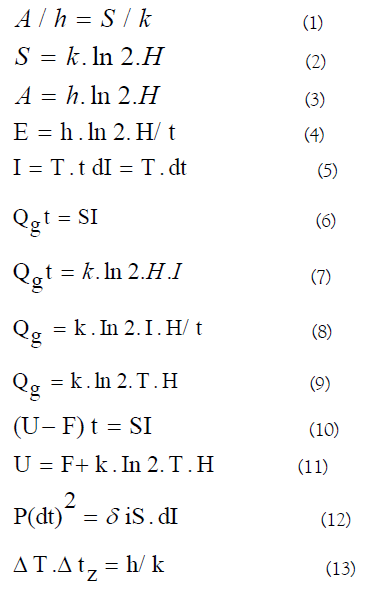
 Boltzmann distribution or canonical distribution (14)
Boltzmann distribution or canonical distribution (14)
 Boltzmann-Planck relationship (15) For different microstates with the probabilities Wi:
Boltzmann-Planck relationship (15) For different microstates with the probabilities Wi:

For quantum statistical entropy (quantum information) one obtains the functional expression

 Entropy production (19)
Entropy production (19)
 De Donder's Irreversibility performance (also called degree of irreversibility) (20)
De Donder's Irreversibility performance (also called degree of irreversibility) (20)
 Irreversibility effect (21)
Irreversibility effect (21)
Meaning of the symbols used
Quantities
A = Action
AH = The area of the black hole event horizon that measures the information potentially contained in it
bi = Width of the i-th symbol
ß' = Distribution module
E = Energy
F = Free energy
H = SHANNON’s information entropy
I = Immanence = T · t
M = Mass of the universe
N = ∑ ni = Sum of a total of N symbols
ni = Number of i-th type symbols
Pi = Probability of drawing a symbol of type i as the next symbol (letter probability)
P = De Donder’s irreversibility performance
 Density operator (also statistical operator or density matrix) its characteristics are:
Density operator (also statistical operator or density matrix) its characteristics are:
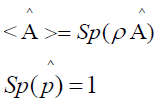
 (Positively defined hermitic operator)
(Positively defined hermitic operator)
The eigenvalue ɑ for the appropriate eigenstate thereby corresponds to the measured value of the measured  in the condition │ѱ>, and the following is true (with│ѱ> normed to 1):

Qg = Bound energy = TS
QH = Bound energy that corresponds to TH SH
Qg · t = thermodynamic effect
R = Radius of the universe (cosmic radius, radius of curvature of the cosmos)
S = Thermodynamic entropy
SH = Black hole entropy (Bekenstein-Hawking entropy)
T = Absolute temperature
TH = Hawking temperature
ΔT = Temperature difference that the cell must maintain in order for waste heat to be released into the environment
t = Time
Δtz = Working cycle duration of cell
U = Inner energy
W = Thermodynamic probability (better: complex ion number) is obtained by calculating the number of molecule configurations corresponding to a given macro-state
W = Thermodynamic probability of a system to assume a certain micro-state
Z = State sum or partition function
Constants
c = Speed of light in a vacuum
G = Gravitational constant
h = Planck’s quantum of effect
ħ= h / (2π)
H0 = Hubble constant
k = Boltzmann’s constant
Units
cm = Centimetre
g = Gramm
J = Joule
K = Kelvin
kg = Kilogram
s = Second
References
- Ebeling W, Freund J, Schweitzer F. Komplexe Strukt: Entropie Inf.
- Lyre H. Informationstheorie: eine philosophisch-naturwissenschaftliche Einführung. Münch: Fink;2002.
- Lyre H. Quantentheorie der Information: zur Naturphilosophie der Theorie der Ur-Alternativen und einer abstrakten Theorie der Information. Brill mentis.
- e Silva JL, Lochak G. Wellen und Teilchen: Einführung in die Quantenmechanik. Fisch Taschenb Verl; 1974.
- Jöge FM. Information & Effect: An Introduction to the Concept of Immanence as a Physical Quantity.
- Pagel L. Information ist Energie. Springer Fachmedien Wiesb; 2013.
- Eigen M. Von der Entropie zur Information—die physikalische Chemie der belebten Materie. 1994;98(11):1351-64.
- Penrose R. The emperor’s new mind Oxford University Press. New York. 1989.
- SEDLACEK K. Äquivalenz von Information und Energie. Norderstedt: Books on Demand GmbH Verlag,. 2010.
- Zeilinger A. Einsteins Schleier: die neue Welt der Quantenphysik. CH Beck; 2003.
- Sheldrake R. Das schöpferische Universum: die Theorie des morphogenetischen Feldes. Meyster; 1983.
- Hashmi D. Biodiversity wave mechanics: a physics for living systems. Cuvillier Verl; 2002.
- Kornwachs K, Jacoby K. Information: New questions to a multidisciplinary concept. Gruyter Akad Forsch; 1996.
- Weizsäcker EU. Offene Systeme/1 Beiträge zur Zeitstruktur von Information, Entropie u. Evolution/hrsg. von Ernst Ulrich von Weizsäcker, Entropie Evol. 1974.




